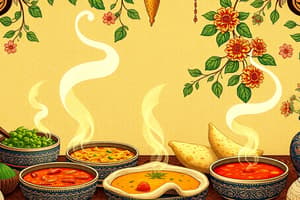Podcast
Questions and Answers
مشرقی اور مغربی بھارتی کھانے میں کیا فرق ہے؟
مشرقی اور مغربی بھارتی کھانے میں کیا فرق ہے؟
اشیاء
کنکر، مرغ، موٹن اور چوزے سمیت کون کون سی چیزیں بھارتی کھانوں میں شامل ہوتی ہیں؟
کنکر، مرغ، موٹن اور چوزے سمیت کون کون سی چیزیں بھارتی کھانوں میں شامل ہوتی ہیں؟
گوشت
بھارتی کھانے میں کتنے قسم کے سبزیاں استعمال ہوتی ہیں؟
بھارتی کھانے میں کتنے قسم کے سبزیاں استعمال ہوتی ہیں؟
سبزیاں
مغربی بھارت کے کھانے میں کون کون سی چیزیں عام ہیں؟
مغربی بھارت کے کھانے میں کون کون سی چیزیں عام ہیں؟
بھارتی کھانے میں کتنی قسم کے مکھن استعمال ہوتے ہیں؟
بھارتی کھانے میں کتنی قسم کے مکھن استعمال ہوتے ہیں؟
بھارت میں پرانے دور کی عام زمانے میں کون سا قسم کا خوراک زیادہ مقبول تھا؟
بھارت میں پرانے دور کی عام زمانے میں کون سا قسم کا خوراک زیادہ مقبول تھا؟
بھارتی رسم کاریوں میں ایک خصوصی خصوصیت کیا ہے؟
بھارتی رسم کاریوں میں ایک خصوصی خصوصیت کیا ہے؟
بھارتی کھانے کی کیا خصوصیت ہے جو مذاق، خوشبو، ٹیکسچر، رنگ، شکل، درجہ حرارت اور ذائقے کی وسیع مجموعہ فراہم کرتی ہے؟
بھارتی کھانے کی کیا خصوصیت ہے جو مذاق، خوشبو، ٹیکسچر، رنگ، شکل، درجہ حرارت اور ذائقے کی وسیع مجموعہ فراہم کرتی ہے؟
بھارتی رسم کاریوں میں کون سی مذاقیں اور خوشبویں پائی جاتی ہیں؟
بھارتی رسم کاریوں میں کون سی مذاقیں اور خوشبویں پائی جاتی ہیں؟
بھارتی کھانے کی کیا ایک خصوصی خصوصیت ہے جو مختلف مذہبوں میں مختلف ہوتی ہے؟
بھارتی کھانے کی کیا ایک خصوصی خصوصیت ہے جو مختلف مذہبوں میں مختلف ہوتی ہے؟
بھارتی کھانے کی کیا ایک خصوصی خصوصیت ہے جو مختلف علاقوں میں مختلف ہوتی ہے؟
بھارتی کھانے کی کیا ایک خصوصی خصوصیت ہے جو مختلف علاقوں میں مختلف ہوتی ہے؟
بھارتی کھانوں میں کیا مختلف علاقوں میں تضاد کا سبب بنتی ہے؟
بھارتی کھانوں میں کیا مختلف علاقوں میں تضاد کا سبب بنتی ہے؟
Flashcards are hidden until you start studying
Study Notes
Indian cuisine is a diverse and vibrant culinary tradition with roots steeped in history and culture. It's known for its use of spices, herbs, and bold flavors. These dishes have evolved over centuries due to various factors such as geography, climate, socioeconomic conditions, religious beliefs, and historical events. Some key aspects of this cuisine include the use of basmati rice as staple food, yogurt, chickpeas, lentils, okra, eggplant, bananas, potatoes, plantains, sweet potatoes, spinach, and mustard greens. A large variety of vegetables form part of traditional Indian cooking, including peas, beans, cauliflower, carrots, radishes, turnips, onions, garlic, ginger, chilies, turmeric, coriander, cardamom, cloves, saffron, fennel seeds, fenugreek seeds, and nutmeg. Many Indian recipes also call for meat like mutton, chicken, fish, pork, beef, duck, goose, quail, rabbit, snake, turtle, kangaroo, alligator, and iguana. However, vegetarian meals were more popular during ancient times because animal sacrifice was common.
The main difference between North Indian and South Indian cuisines lies in their ingredients rather than preparation methods. Southern India uses coconut oil while northern parts prefer sesame seed oil. Coconuts play a substantial role in the dietary habits of many regions in southern India. Curries are another important aspect of Indian cuisine—they can vary from mildly seasoned broths containing little solid matter to thick creamy sauces cooked from tomatoes, chili peppers, and other ingredients. Traditional curry powders typically consist of red pepper, black pepper, cumin, paprika, garam masala, salt, ground mustard, mixed spice, thyme, bay leaves, and star anise. In addition, some regionally specific variations of these basic components exist within Indian cookery.
Another distinctive feature of Indian cuisine is that it varies across different religions. For instance, Hinduism has several restrictions, such as avoiding garlic and onion. On the other hand, Muslim communities do eat those two foods. Meanwhile, Jain communities avoid root vegetables and nightshade plants. Furthermore, there are numerous regional differences among Indian cuisines. While one might be fond of something like Dal Makhani from Punjab, someone else could dislike it if they grew up eating something very unlike it. With so much variation throughout the country, it's impossible to generalize what Indians consider typical foods.
In conclusion, Indian cuisine offers a vast array of flavors, aromas, textures, colors, shapes, temperatures, and tastes. Each dish carries memories of the past, stories of love, family traditions, cultural heritage, and pride in a unique identity. Whether you're savoring the subtle tastes of delicate biryanis or indulging in fiery vindaloes, experiencing Indian cuisine means embarking on a journey through time and space.
Studying That Suits You
Use AI to generate personalized quizzes and flashcards to suit your learning preferences.




